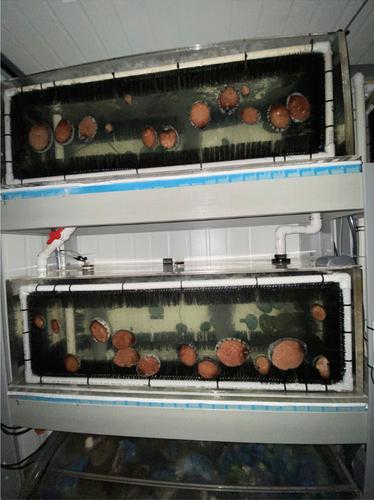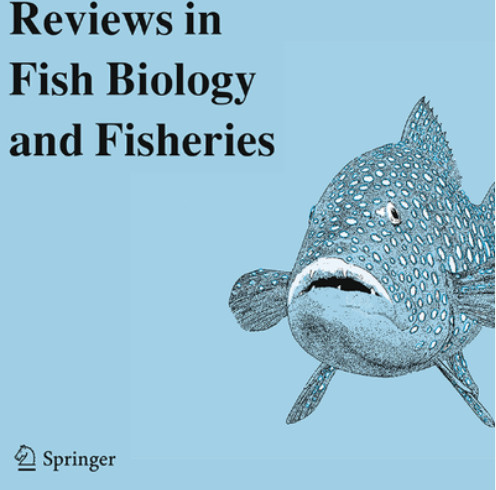Size-dependent thermal limits in Australian hybrid abalone: implications for productivity shifts with ocean warming
IF 4.6
1区 农林科学
Q1 FISHERIES
引用次数: 0
Abstract
Abstract Ocean warming and extreme heatwaves threaten marine species supporting commercial fisheries and aquaculture. Predicting the responses of these industries to chronic and acute warming depends on understanding which life stages are most vulnerable, the potential for stocks to adapt to changing thermal environments, and the availability of thermally adapted genotypes to help enhance stock resilience through strategic interventions. Here, we shed light on some of these knowledge gaps by quantifying the critical thermal maximum (CT max ) of ~ 10–210 g hybrid abalone ( Haliotis rubra × H. laevigata ) from two farms representing contrasting thermal environments from south-eastern Australia. CT max was not dependent on body size or provenance (farm) when heating rates were rapid (1 °C per h), but a significant relationship between CT max and body size was observed when heating rates were slower and more ecologically realistic (1 °C per 12 h). Histological analyses revealed a negative relationship between CT max and the stage of gonadal development when abalone were exposed to chronic thermal stress conditions. These results suggest that marine heatwaves and ongoing ocean warming might favour smaller, less fecund animals in natural and farm settings. This could potentially impact future harvestable biomass, recruitment and population dynamics in wild-capture fisheries, and production of larger, high-value animals in farm settings. This study adds to a growing body of literature pointing to complex and often negative effects of climate change on commercial fisheries, and the potential need for interventions aimed at bolstering fisheries resilience against the effects of ocean warming.

澳大利亚杂交鲍鱼的大小热限制:海洋变暖对生产力变化的影响
海洋变暖和极端热浪威胁着支持商业渔业和水产养殖的海洋物种。预测这些行业对慢性和急性变暖的反应取决于了解哪些生命阶段最脆弱,种群适应不断变化的热环境的潜力,以及热适应基因型的可用性,以帮助通过战略干预增强种群的恢复力。在这里,我们通过量化来自澳大利亚东南部两个养殖场的~ 10-210 g杂交鲍鱼(Haliotis rubra × H. laevigata)的临界热最大值(CT max)来阐明这些知识差距。当加热速度快(1°C / h)时,CT max与体长或种源(养殖场)无关,但当加热速度较慢且更符合生态条件(1°C / 12 h)时,CT max与体长之间存在显著关系。组织学分析显示,当鲍鱼暴露于慢性热应激条件下时,CT max与性腺发育阶段之间存在负相关。这些结果表明,在自然环境和农场环境中,海洋热浪和持续的海洋变暖可能有利于体型较小、繁殖能力较差的动物。这可能会影响未来的可收获生物量、野生捕捞渔业的招募和种群动态,以及农场环境中大型高价值动物的生产。这项研究增加了越来越多的文献,指出气候变化对商业渔业的复杂且往往是负面影响,以及潜在的干预需求,旨在增强渔业抵御海洋变暖影响的能力。
本文章由计算机程序翻译,如有差异,请以英文原文为准。
求助全文
约1分钟内获得全文
求助全文
来源期刊

Reviews in Fish Biology and Fisheries
农林科学-海洋与淡水生物学
CiteScore
10.00
自引率
8.10%
发文量
42
审稿时长
12-24 weeks
期刊介绍:
The subject matter is focused on include evolutionary biology, zoogeography, taxonomy, including biochemical taxonomy and stock identification, genetics and genetic manipulation, physiology, functional morphology, behaviour, ecology, fisheries assessment, development, exploitation and conservation. however, reviews will be published from any field of fish biology where the emphasis is placed on adaptation, function or exploitation in the whole organism.
 求助内容:
求助内容: 应助结果提醒方式:
应助结果提醒方式:


